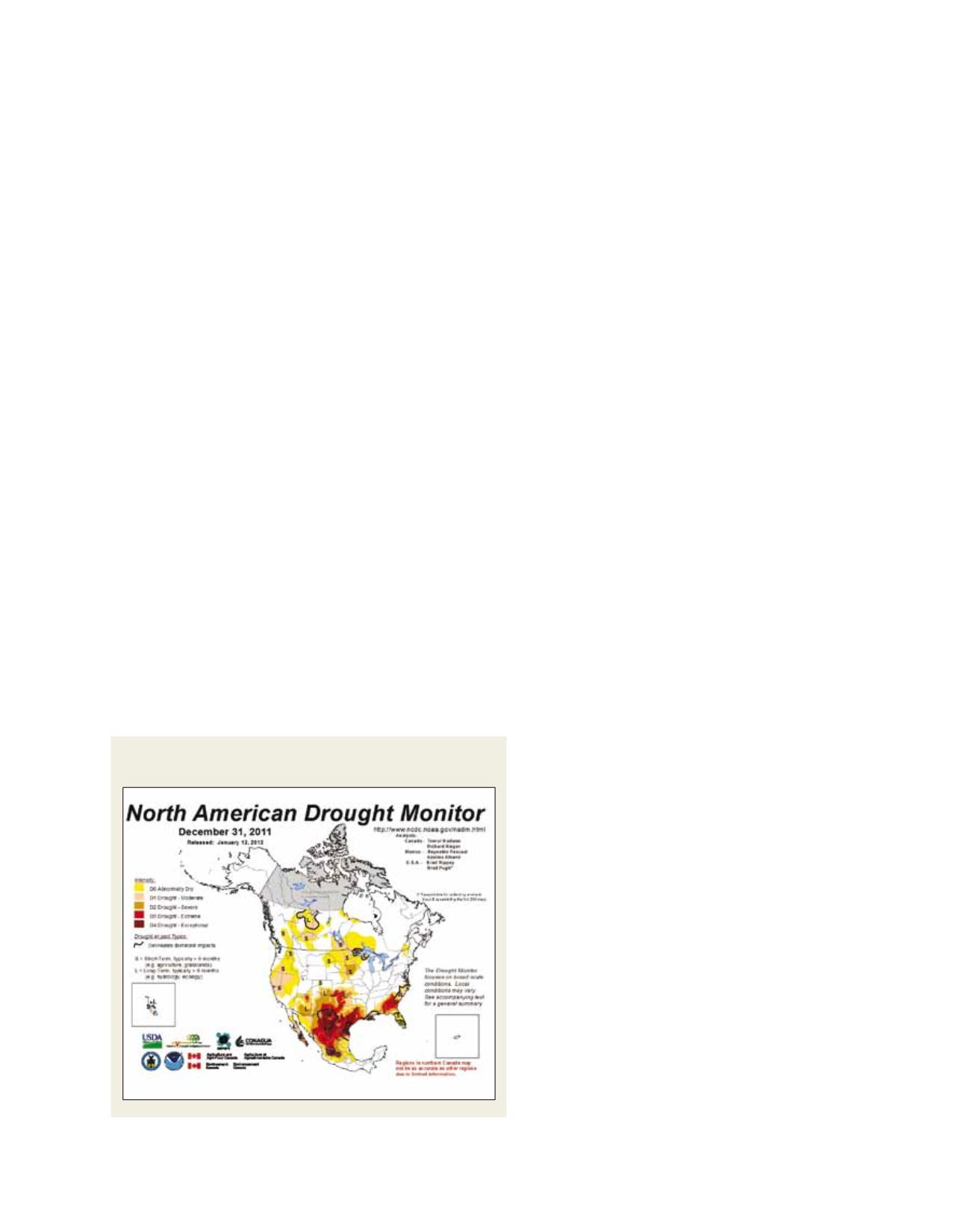

[
] 138
D
isaster
R
isk
R
eduction
billion) by 2030 to safeguard and modernize infrastruc-
ture by sealing leaky pipes, expanding reservoirs and
recycling household wastewater.
In Canada, the Pasture Recovery Program was an
initiative to encourage producers not to put cattle on
damaged pasture early in the spring of 2010, and to
assist them in purchasing extra feed supplies. NADM
products were used in designating the producers eligi-
ble to receive the payments, which were based on the
number of cattle the producer had within the impacted
region and totalled Can$67.2 million in Alberta and
Can$16.9 million in Saskatchewan.
12
In the US, the USDM, which becomes the US portion
of the NADM each month, is used by many states as a
trigger in their drought plans, and by the USDA as a crite-
rion for allocating drought relief funds. The USDA’s Farm
Service Agency (FSA) and its predecessors administer
commodity, conservation and farm lending programmes
to about two million agricultural producers. The FSA
programmes are legislated through farm bills (passed by
the US Congress every five to six years), annual appropri-
ations and disaster emergency acts. In 2006, state block
grants totalling US$50 million were allocated through the
Livestock Assistance Grant Program, and in fiscal year
2010 the USDA provided US$1.9 billion in supplemental
agricultural disaster assistance outlays where the damage
was due to drought or other adverse weather.
13
Drought
relief funds allocated through the Livestock Forage
Program totalled US$165 million in 2008, US$99 million
in 2009, US$33 million in 2010 and US$255 million in
2011.
14
In the 2008 Farm Bill’s disaster declaration and
designation process, the USDM provides a quantifiable
standard for determining a qualified county: those that
experienced a USDM drought category of D2 (severe
drought) for a minimum period of two months would
qualify, while D3 (extreme drought) or worse automati-
cally qualified the county as a disaster area.
Operational production of the NADM
The NADM is not imposed on participants by an outside
agency; it is a bottom-up collaborative activity by the
participants. Experts within each participating country
independently determine that country’s drought depic-
tion and construct a narrative describing its drought
conditions. The NADM is produced monthly in an
ArcGIS environment by a lead author who integrates the
national drought depictions and narrative discussions
from the three countries into a continental map and
narrative. The lead author changes every month, rotat-
ing from among personnel at six of the NADM partner
agencies and organizations. The 2012 author schedule
is typical of an annual schedule, including:
• Canada: AAFC personnel lead authoring for two of
the 12 months
• Mexico: SMN personnel lead authoring for two months
• US: NDMC personnel lead authoring for two months,
USDA personnel lead authoring for one month, CPC
personnel lead authoring for two months, and NCDC
personnel lead authoring for three months.
southern US and northern Mexico reduced streamflow along the
Rio Grande/Bravo River system. The NADM provided a collaborative
drought monitoring tool which assessed the severity of drought in
the region, providing valuable information which could be used by
decision makers on both sides of the border to better manage water
resources held in US and Mexican reservoirs along the river system.
Academic studies have attempted to estimate the costs associ-
ated with drought. According to Anil Markandya, Director of the
Basque Centre for Climate Change, drought affects around 25 per
cent of gross domestic product in developed countries – and more
in developing countries.
6
The total cost of droughts over the past
30 years in Europe amounts to
€
100 billion (about US$132 billion
or US$4.4 billion per year on average).
7
In the US, droughts cause
direct losses that average between US$6 billion and US$8 billion per
year.
8
According to a Manitoba government study in 2002, the 2001
Prairie drought cost the Canadian economy over Can$5 billion in
agricultural losses.
9
Since the NADM is an operational activity with no specific line-
item budget, funding has not been available to engage an economist
to perform an NADM cost-benefit analysis. Furthermore, while
many commercial users have indicated that they use the NADM in
their business decisions, they are reluctant to release proprietary
financial information that could help NADM producers determine
the savings achieved by using the product. However, some estimate
of NADM-based cost savings can be obtained from data released by
Government agencies.
Government agencies and academic institutions such as univer-
sities and research institutes in Mexico, the US and Canada are
heavy users of the NADM. In Mexico, the NADM is an impor-
tant criterion for drought-related decisions made at the highest
levels of Government.
10
According to a Reuters news report,
11
the
Government has allotted MXN34 billion (US$2.65 billion) in emer-
gency aid to confront the 2011-2012 drought; and water authority
CONAGUA says it must invest over MXN300 billion (US$23.68
The North American Drought Monitor for the end of
December 2011
Source: NOAA
















